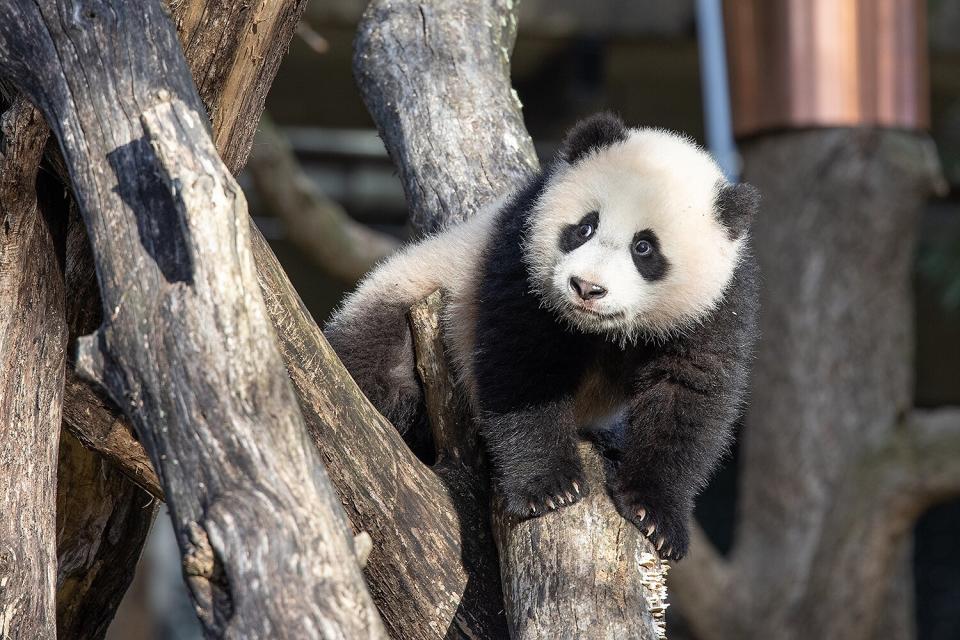The National Zoo's Panda Cub Is Learning to Climb Trees and Roll Down Hills: 'It's Pretty Cute'

At seven months old, Washington, D.C.'s giant panda cub Xiao Qi Ji, born last August during the ongoing COVID-19 pandemic, is exploring his world at the Smithsonian's National Zoo & Conservation Biology Institute — which is still closed to the public due to COVID restrictions.
While animal lovers haven't been able to watch the cub grow in person, the public has fallen in love with him through the zoo's panda cam.
"His favorite thing to do is play with Mom, so if you get a chance to see that on the panda cam, that's really special," Nicole MacCorkle, a panda keeper for 20 years, tells PEOPLE.
Mom Mei Xiang and Xiao Qi Ji play like pandas — running after each other, biting, climbing, somersaulting down the hill. "When one of them starts rolling, a lot of times the other one will roll," MacCorkle says. "It's pretty cute."
RELATED: The National Zoo Panda Cub Is 6 Months Old and He's Ready to Enjoy the Outdoors — Snow Included

Courtesy Smithsonian's National Zoo and Conservation Biology Institute
The zoo's staff has built a jungle gym for the cub so he can learn to climb. It's a safe place to practice climbing because it's not as tall as the trees, and if he gets stuck at the top, Mom or a keeper can help him get down.
"Climbing up the trees usually comes before figuring out how to climb down," MacCorkle explains. But Xiao Qi Ji turned out to be good at both. Maybe it has something to do with Mom's parenting style.

Courtesy Smithsonian's National Zoo and Conservation Biology Institute
Xiao Qi Ji is Mei's fourth surviving cub, so she's been through this before. "She's a little more laid back with each cub," MacCorkle says. "She's a very skilled and very relaxed mom. Certainly, if she needs to step in, she will, but she watches from a distance for the most part. She knows what he's doing and keeps an eye on him, but she's not hovering. She's not a helicopter mom."
Mom does have command, though. When outdoor time is over and it's time to go inside, she sits at the bottom of the climbing structure and calls her cub. Sometimes it's head first, sometimes feet first, but he always comes right down.

Courtesy Smithsonian's National Zoo and Conservation Biology Institute
Standing on his hind legs, the cub comes up to about knee level on his keepers. "He's still pretty low to the ground. He's not going to be big for a while," MacCorkle says.
Still, as the panda bear cub is getting older, the zookeepers have to be more careful with their interactions. They reinforce good behavior with praise or treats and ignore or redirect bad behavior. "We don't want him chewing on keepers or biting our legs," she says. "We redirect him. We'll give him a toy or something that is acceptable to chew on. It's very similar to the way you would train a puppy."
Xiao Qi Ji has a sweet tooth. He loves sweet potatoes, apples, and pears, but he's not crazy about bananas. He has a favorite ball toy with a handle and plays tug-of-war with his keepers or rolls around with the ball by himself. The keepers have taught him to climb up on a scale and sit still, so he is easy to weigh. On Wednesday, he weighed in at a healthy 36 pounds and is gaining steadily.

Courtesy Smithsonian's National Zoo and Conservation Biology Institute
Even though Xiao Qi Ji is smaller than his mom, when just one panda is on the panda cam, it can be hard to tell if it's the mother or the cub. MacCorkle has a tip. Adult pandas don't spend a lot of time in trees. That's more of juvenile behavior — so if you see one panda on the climbing structure or in the hammock, it's typically the cub.
"He's doing what he would if he were a wild panda: he has a little milk in the morning, and then he plays a little and has a nap for several hours."

